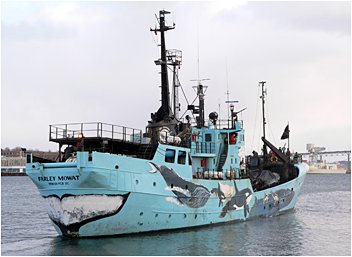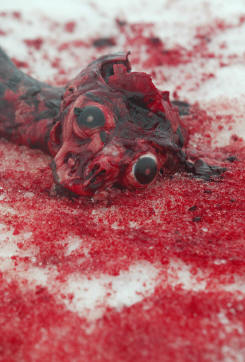|
(home)
Something (else) is Rotten
in the Gulf of St. Lawrence
by Debbie MacKenzie, March 8, 2005
Which is worse,
environmentally: the remote possibility that a ship will spill
one drop of oil, or the
deliberate dumping of a massive amount of harmful waste into
an area of sensitive fish habitat, where a threatened cod
stock struggles to survive? Canadian law strictly prohibits
each of these environmental hazards. But law enforcement varies,
as sometimes officials seem to look the other way. Consider
the polluting impact of the seal hunt in the Gulf of St. Lawrence.
Last week, the Farley Mowat, a ship belonging to seal hunt protesters,
the Sea Shepherd Conservation Society, was detained for four
days in Halifax Harbour while federal officials enforced a new,
strict anti-oil-pollution order on the vessel. The activists
hastily complied with unexpected new orders, and installed what
had till then been officially considered unnecessary, a redundant
back-up system for waste oil containment. Had they been unable
to modify the Farley Mowat so quickly, the protesters might
have been prevented from reaching the Gulf of St. Lawrence in
time for the mid-March start of the seal hunt. But, better safe
than sorry. (Photo of the Farley Mowat in
Halifax Harbour, at right, from www.seashepherd.org
)
The conscientious concern of our federal officials in safeguarding
the sensitive Gulf of St. Lawrence ecosystem against the harmful
effects of oil pollution is commendable. After all, fish and
other marine animals in the Gulf face more intense threats from
habitat degradation than they do in many other regions in Atlantic
Canada. The Gulf contains relatively stagnant bottom water because
it is sheltered from the great ocean currents that skirt the
outer coasts of Newfoundland and Nova Scotia. This physical
characteristic of the Gulf of St. Lawrence makes it naturally
vulnerable to the deadly problem of rot settling in on bottom,
a subtle process by which bacterial decomposition of dead organisms
drains oxygen from the water, and renders it lethal to fish.
Called hypoxia, or “dead zones,” this is a serious rising threat
in semi-enclosed waterways globally.
DFO scientists have recently published their finding that a
massive region of the Gulf contains bottom water oxygen levels
so low today that cod and other fish can be (and likely are
being) sickened or killed as a result. The cod stock in
the northern Gulf is in such bad shape that it has been listed
under the Species At Risk Act. Under the Fisheries Act it is
illegal to damage fish habitat by adding any “deleterious substance”
to the water. “Deleterious” to current conditions in the Gulf
is the addition of any more rot-fodder to the bottom water,
because such pollution will only cause hypoxic conditions to
intensify. This is not a new concept.
Why, then, does DFO allow seal hunters to abandon hundreds of
thousands of seal corpses on the ice in the middle of the Gulf?
Sealers normally remove only the pelts, and leave the seal corpses
to rot. This practice, added to unknown numbers of wounded seals
that escape to die later, results in a rain of sinking, rotting
seal corpses that can only work to further stifle - quite literally
- the recovery of cod stocks.  Dead
seal flesh dumped annually into the waters of the Gulf by sealers
likely exceeds 1000 tons, and the ensuing rot can certainly
suffocate cod. However, no permits for “at sea disposal” of
bulk organic waste appear to have been issued to the sealers,
(although the law normally requires permits for the disposal
of far smaller quantities of fish waste), and no appropriate
“environmental impact assessment” has been done (although, as
the agency responsible for enabling the seal hunt, DFO is obliged
to do this under the Canadian Environmental Assessment Act).
What a mess - and to think that this seal hunt has been sold
to the public as a “cod stock recovery plan.” Dead
seal flesh dumped annually into the waters of the Gulf by sealers
likely exceeds 1000 tons, and the ensuing rot can certainly
suffocate cod. However, no permits for “at sea disposal” of
bulk organic waste appear to have been issued to the sealers,
(although the law normally requires permits for the disposal
of far smaller quantities of fish waste), and no appropriate
“environmental impact assessment” has been done (although, as
the agency responsible for enabling the seal hunt, DFO is obliged
to do this under the Canadian Environmental Assessment Act).
What a mess - and to think that this seal hunt has been sold
to the public as a “cod stock recovery plan.”
Sealers should face unlawful pollution charges if they abandon
seal corpses on the ice or in the water. And, to be safe and
to be fair, federal officials should now take the precaution
of detaining all sealing vessels in port, and enforcing compliance
with the new oil pollution prevention rules, before any of these
boats are allowed to enter the Gulf this spring. Sadly, however,
it seems it is only the seal hunt protesters, who decry the
ecological insanity and the inherent cruelty of the hunt, that
risk being charged with any seal hunt-related offence by Canadian
law enforcement officials.
What, besides pollution prevention, might help counteract the
growing “dead zone” in the Gulf of St. Lawrence? The answer,
ironically, is more live seals.
(Photo
above, rotting seal corpse left on ice in the Gulf of St. Lawrence by
sealers, reproduced from
www.harpseals.org - photo credit IFAW
)
See also:
Something is Rotten in the Gulf of St. Lawrence
(more on the hypoxia problem)
Advice
to Ocean Ecosystem Managers: Trust the Seals, Fear the Microbes...
Nova Scotia Grey Seal Hunt, 2004 (a review
of the ecological arguments against all commercial seal hunts)
Many groups are raising protests in an effort to stop the Canadian harp
seal hunt in 2005. For more information see:
Sea Shepherd Conservation Society
http://www.seashepherd.org
Humane Society of the United States
http://www.hsus.org
International Fund for Animal Welfare
http://www.ifaw.org
Harpseals.org http://www.harpseals.org
ProtectSeals.org
http://www.protectseals.org
please
sign our guestbook
View
Guestbook  Sign Guestbook
Sign Guestbook
|

 Dead
seal flesh dumped annually into the waters of the Gulf by sealers
likely exceeds 1000 tons, and the ensuing rot can certainly
suffocate cod. However, no permits for “at sea disposal” of
bulk organic waste appear to have been issued to the sealers,
(although the law normally requires permits for the disposal
of far smaller quantities of fish waste), and no appropriate
“environmental impact assessment” has been done (although, as
the agency responsible for enabling the seal hunt, DFO is obliged
to do this under the Canadian Environmental Assessment Act).
What a mess - and to think that this seal hunt has been sold
to the public as a “cod stock recovery plan.”
Dead
seal flesh dumped annually into the waters of the Gulf by sealers
likely exceeds 1000 tons, and the ensuing rot can certainly
suffocate cod. However, no permits for “at sea disposal” of
bulk organic waste appear to have been issued to the sealers,
(although the law normally requires permits for the disposal
of far smaller quantities of fish waste), and no appropriate
“environmental impact assessment” has been done (although, as
the agency responsible for enabling the seal hunt, DFO is obliged
to do this under the Canadian Environmental Assessment Act).
What a mess - and to think that this seal hunt has been sold
to the public as a “cod stock recovery plan.”